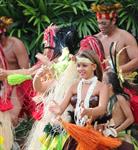The main objective of this style of photography is to lift the subject or model out of their daily reality and take flattering photos of them. There is an art to using light and shade, cropping, posing, make-up, filters, styling and lens selection to enhance the most attractive aspects of a person and disguise those they may find less desirable. More than just a cosmetic skin smoothing and toning effect, however, the real art lies in bringing out someone's inner beauty.
Bringing out someone's inner beauty requires not only an ability to see their inner beauty, but an ability to make your subject comfortable and relaxed. A countenance that allows them to play and reduces any self-consciousness they may feel. In addition to allowing spontaneous play, however, you should be well prepared for the shoot and have a list of shots already planned in your head before they arrive. Concentrate on the models eyes and look for that expression in them you want to capture. It also helps if you mirror the look you want with your eyes and ask the model to look into your eyes; this should influence them to copy your eye and facial gestures. Much of glamour photography is about capturing the eyes that will bring the viewer into the image, to give that special connection. Although not ‘a glamour’ shot, one of the most memorable photographs of all time is Steve McCurry’s image of ‘The Afghan girl’ for National Geographic. The connection with the eyes in that image is truly remarkable.
When working with a model ensure the directions are clear and precise, including not only physical the posing instructions but emotional cues also when necessary. Use your hands to direct the model to the way you would like them to move and pose/ position themselves. Try not to use ‘move left’ and ‘move right’, as this leads to the confusion of ‘your left’ or ‘my left’. Remember the model is intensely focused and concentrating on their pose, so simple hand gestures and words help for better communication, between you and the model.
The photo shoot is generally broken up into stages. Firstly there is an introduction - these photographs that create the right mood and portray a theme. Secondly, you aim to tell a story in great detail with the shots, and finally there is the experimental stage. The experimental stage is where both the photographer and the model get to play with lighting, posing, composition and technique.
 Setting, Clothing and Make-up
Setting, Clothing and Make-up
Both the setting and the clothing are obviously important. Clothing which is too tight will pinch the skin and leave marks, or highlight fat and cellulite most people do not like to admit they have. Clothing which is too revealing may also show areas of fatty tissue that most people dislike to admit they have, and clothing which is too loose can make people look larger than they naturally are.
Make-up such as foundation which may look fantastic under regular lighting conditions can look awful with a studio flash as the light can highlight the oil, creating glowing shiny spots rather than a matt smooth skin appearance. Powder must be applied on top of the foundation. Too much powder, however, can collect in creases and age the person. Remember that photography captures everything in great detail so all make-up must be expertly applied and not overdone unless that is the look you require. A good practice is to use a professional makeup artist to complete the models makeup. A well trained artist should also have a good knowledge of what foundation bases will give the skin a yellow, grey or blue tone in various types of lighting.
Like make-up hair styling can also be used to complement the subject and disguise less flattering features. If the subject is your client, it would be wise to ask them how they like their hair. There's nothing worse than taking a brilliant photograph of someone only to have them complain: ‘But there's a hair on my forehead’ or, ‘I never part my hair on that side’! Of course many things can be fixed in Photoshop but the amount of time this takes in enormous when compared to the time it might take to sweep their hair aside or ask them to adjust their clothing.
The course aim is to take better photographs of people, and it provides a foundation for taking formal portraits through to informal group or crowd scenes.